Sikhism - Sikh Gurus - Guru Har Gobind
Guru Har Gobind was born to Guru Arjan Dev on June 19, 1595 at Wadali, a village near Amritsar. The period of Guru's early life is alluded to in the previous chapter. After the Martyrdom of his father (Guru Arjan), the Guru caused the Adi Granth to be read by Bhai Buddha and the musicians of the temple sang the Guru's hymns. This lasted for ten days. When the final rites were over, Bhai Buddha started the ceremony of Guruship. It should be remembered here that when Guru Arjan's wife went to Bhai Buddha for boon of a son, she had prepared the meals with her own hands, and she took bread with onions. Bhai Buddha while eating had said," The Guru is the owner of the storehouse, but I have received an order to open it. As you have given me food to my heart's content, so shall you have a son to your heart's content. He shall be very handsome and brave, possess spiritual and temporal power, become a mighty hunter, ride on royal steeds, wear two swords, be puissant in battle, and trample on the Mughals. As I crush these onions you have brought to me, so shall your son crush the heads of his enemies, and be at once a great warrior and exalted Guru. His shall not be the humble seat of a village Guru, but a gorgeous imperial throne."

As usual Bhai Buddha placed before the Guru a seli (a woolen cord worn as a necklace or twisted round the head by the former Gurus) and a turban, as appurtenances of his calling. The Guru ordered the seli to be placed in the treasury and reminding him about his prophecy said to Bhai Buddha,"My endeavors shall be to fulfil thy prophecy. My seli shall be a swordbelt, and I shall wear my turban with a royal aigrette. Give me a sword to wear instead of seli." The sword was brought but Bhai Buddha placed it on the wrong side of Guru Har Gobind. The Guru said,"Bring another one, I shall wear two swords." He wore two swords which were emblems of Spiritual and Temporal authority- Piri and Miri- the combination of 'Bhakti and Shakti'.
Akal Takhat (Timeless Throne)
The martyrdom of Guru Arjan was an unparallel act in the history of mankind. The Guru had all the superpowers. He could have averted the situation in any way he liked, but he went through all that torture to show to the world how in all thick and thin one should cheerfully submit to the sweet Will of God.
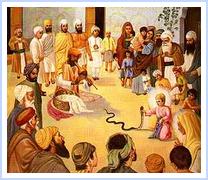 |
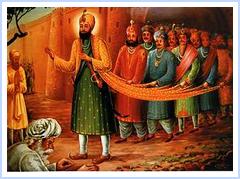 |
The cruel and torturous execution of Guru Arjan aroused a very strong wave of angry feelings among the masses. The enlightened, but not passive, sufferings of the Guru instilled a new spirit and life into the people and they resolved to exert and sacrifice themselves for the sake of righteousness. Some Masands represented to the Guru's mother and requested for their safety. She showed courage to the Masands, however, she remonstrated with the young Guru,"My son, we have no treasure, no state revenue, no landed property and no army. If you walk in the way of your father and grandfather, you will be happy." The Guru recited the following verse:
"The Lord who is the Searcher of all hearts Is my own Guardian." (Bhairon Mohalla 5, p-1136)
and said,"Have no anxiety and everything shall be according to the Will of God."
The Guru issued an order to the Masands that he would be pleased with those who brought offerings of arms and horses instead of money. He laid down the foundation of Akal Takhat (Timeless Throne) in 1606 (the fifth day of light half of month of Har, Sambat 1663) just in front of Hari Mandar, and it was completed in 1609. Akal Takhat was built of solid bricks on a raised platform of about ten feet in height and looked like a throne. The Guru took his seat on it. He built Akal Takhat a few yards in front of Hari Mandar with a view that a Sikh at Akal Takhat should not forget that spiritual elevation was as essential as his social obligations. As a matter of fact, the Guru wanted his followers to be 'saint-soldiers', extremely cultured, highly moral with spiritual height and be ever-ready to measure swords with demonic forces. Bhai Buddha on seeing the Guru in military harness, mildly remonstrated with him. Instead the Guru replied,"In the Guru's house religion and worldly enjoyment shall be combined- the caldron to supply the poor and the needy, and the scimitar to smite the oppressors." (This should be noted by those Sikhs who say that worldly and practical affairs should be kept separate from religion in our Gurdwaras).
Several warriors and wrestlers came to the Guru for service. He enrolled fifty-two heroes as his body-guard and this formed the nucleus of his future army. About five hundred young persons came from all over the Punjab to enlist in his service. He made Bhai Bidhi Chand, Bhai Jetha, Bhai Piara, Bhai Langaha, and Bhai Pirana, each captain of a troop of one hundred horse. People began to wonder how the Guru could continue to maintain such an army. The Guru quoted:
"God provideth every one with his daily food; why, O man, art thou immersed planning;
He putteth their food even before the insects which He created in rocks and stones."
(Gujri Mohalla 5, p-495)
Akal Takhat grew into an institution which symbolized in itself the idea that the use of sword for the protection of righteousness and for self-defence was called for. Here the Guru sitting on his throne, would watch wrestling bouts and military feats of his disciples performed in the open arena opposite to the Akal Takhat. As all intricate cases and disputes were finally decided here by the Guru, the Akal Takhat served the purpose of a Supreme Court for the Sikhs. Besides throne, the Guru adopted all other emblems of royalty- the umbrella, the swords, the crest and the hawk, and thus the Sikhs called him a true king or 'Sacha Padshah'- a king in all appearance but in deeds and in purity as holy and great as previous Gurus. People looked towards Akal Takhat for guidance in their secular affairs. This custom became so significant that the decision once taken at Akal Takhat was followed by the Sikhs enthusiastically and this was the reason that they were always able to overcome every peril. The development of this custom contributed a lot towards the consolidation of the Sikh Movement.
Mughal Forces and Guru Hargobind
In 1628 the city of Amritsar witnessed the first onslaught on it by the Mughals. Shah Jahan, who succeded his father in 1627 knew that Sikhism had undergone a metamorphosis under Guru Hargobind, the only son of the martyred fifth Guru. This according to the Bhatt Vahi Multan Sindis, was fought on Baisakh 17,1691 Bk/14 April 1634. He had donned two swords of Miri (temporal) and Piri (spiritual), had raised an Akal Takht (1609), built Lohgarh (fortress), collected arms,3 recruited Pathan mercenaries under Paindeh Khan and was giving military training to his followers. On a pretext of getting a royal hawk released from the Guru an expedition of 7,000 strong under Ghulam Rasul Khan Panj Hazari and Mukhlis Khan, Deputy Nazim, was sent. Guru Hargobind would not have liked to make the holy place a battle-ground and had enjoined that "the Harimandir is specially devoted to God's service. It should never be defiled with any impurity of the human body ". He was busy making preparations for the wedding of his daughter Bibi Viro . The combat with royal forces took place at Gumtala, then a suburb of Amritsar. Guru Bilas Patshahi Chhevin 4 gives a vivid account of the encounter, the feats of valour displayed by Bidhia , Jetha, and Piraga each at the head of 100 villagers from Kambowal, who at the moment had arrived to pay homage to the Sixth Guru. The royal troops suffered heavy casualities, including those of Mukhlis Khan the commander of the Mughal army, Maula Bux, son of Qutb-ud-Din, a Qazi of Lahore and Zaffar Beg, a commander. Ghulam Rasul Khan fled. Those thirteen killed on the Guru's side were Bhais Nand, Jait, Piraga, Tota, Tiloka, Sain Das, Paira, Bhagtu, Ananta, Nihala, Takhtu, Mohan and Gopal.5 They died in the defence of the city, the temple and the Guru.
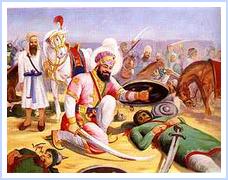 |
 |
Soon afterwards Guru Hargobind left Amritsar, this time taking with him the holy Granth Sahib seated in the Harimandar. The first long halt was at Darauh, near Moga, in present-day Faridkot district. From there Gura Hargobind sent the Granth Sahib with the family to Kartarpur. He himself sojourned in the Malva, visiting his Sikhs and confronting, on 16 December 1634, the Mughal troops in yet another battle, this time at Lahira, near Mehraj, now in Bathinda district. Another armed clash took place at Kartarpur on 29-30 Baisakh 1692 Bk/26-27 April 1635, when Guru Hargobind's own erstwhile Pathan follower, Painda Khan, led out a Mughal force against him. According to writers, Teja Singh and Ganda Singh, Guru Hargobind had won four battles, but as his purpose had always been only defensive.
Guru Hargobind finally retired to Kiratpur where he spent the remaining nine years of his life in peace. The town was of the Guru's own creation and had existed since Baba Sri Chand had, according to the evidence of the Bhatt Vahis, broken ground at his request, on Baisakh suds Puranmashi 1683 Bk/l May 1626. The site had been gifted by Raja Kalyan Chand of Kahlur, one of the chieftains who had won their reprieve at Gwalior through Guru Hargobind's intercession. Kiratpur now became the centre of the Sikh faith. Sikhs came here from all parts to see the Guru. Guru Hargobind gave most of his time to religious devotions. Contact was maintained with sangats in farflung places, and old warriors like Bidhi Chand were sent out as preachers. For Sikhs the roles of saint and soldier had become mutually complementary. About the Guru himself, Bhai Gurdas wrote: "Great hero is Guru Hargobind. He is the vanquisher of armies, but his heart is full of love and charity." This synthesis of the heroic and the spiritual was Guru Hargobind's distinctive contribution to the evolution of Sikh society.
Guru's Family
The Guru had five sons and one daughter. They were:
- Baba Gurditta was born to Mata Damodri in 1613.
- Bibi Viro was born to Mata Damodri in 1615.
- Baba Surj Mal was born to Mata Marwahi in 1617.
- Baba Ani Rai was born to Mata Nanaki in 1618.
- Baba Atal Rai was born to Mata Nanaki in 1619.
- Baba Tegh Bahadur was born to Mata Nanaki in 1621.
There lived a Sikh, Gurmukh in Amritsar who had the only son, Mohan. Baba Atal and Mohan used to play together. One day they played until nightfall. The victory remained with Baba Atal and it was agreed upon that the play would be resumed the next morning. When Mohan went out, he was bitten by a cobra and the boy succumbed to death. Next morning Baba Atal Rai went to Mohan's house and was told that Mohan was dead. Baba Atal did not believe that he was dead and he lifted the dead Mohan to life.
Upon this the Guru angrily addressed to his son," You must be working miracles, while I teach men to obey God's Will." Baba Atal replied," Great King, may you live for ages, I depart for Sachkhand (heaven)." By saying this, he left and went to bathe in the tank of nectar. After his ablutions, he circumambulated the Golden Temple four times. As he finished his morning devotions, his light blended with the Light of God when he was nine years old.
Guru Har Gobind narrated all the circumstances to his eldest son Gurditta and sent him to Budhan Shah, whose devotion he commended. Baba Gurditta took his wife Natti and his son Dhir Mal and met Budhan Shah on the bank of river Satluj. Baba Gurditta reminded,"O priest, thou hast the milk that was entrusted to thee. Bring that to me. The Guru is my father, and he has sent me to taste it." Budhan Shah gave the milk and it is said that it was as fresh as it had been set. Baba Gurditta and his wife Natti continued to reside in Kiratpur. A son was born to them on January 16, 1630 and they called him Har Rai.
Bhai Buddha
Bhai Buddha remained in his village of Ramdas intent on his devotions. When he saw his end near, he asked for the Guru to come and fulfil his promise once he made to him. He told him,"Bhai Buddha, you have lived long, you have been ever with the Gurus. Give some instruction." Bhai Buddha replied,"Great King, thou art a sun, I am a fire-fly before thee. You have come to save me, and to hear my dying words........I have been a servant of the Guru's house for six generations. Succor me in the next world, and allow me not to suffer when I enter death's door, which I fondly hope is the portal of salvation. Here is my son, Bhana at your service; take his arm and keep him at your feet." The Guru replied, "Bhai Buddha, you shall assuredly obtain bliss. Your humility is an assurance." He then put his hand on Bhai Buddha's head and blessed him who then left for his heavenly abode. The Guru and his Sikhs sang congratulations on the event of Bhai Buddha's death after his long, holy and eventful life, and lauded him for the assistance he had given in the propagation and consolidation of Sikh faith. The Guru himself ignited his funeral pyre.
Guru Hargobind at Kiratpur
He lived in Kiratpur from 1635 to 1644. He chose Kiratpur, a city in the foothill of the Himalayas, which was not so easily accessible during those days of undeveloped and scanty means of transportation and communication, to ward off any further hostility between the Sikhs and the Mughal government after the confrontation of four battles. There were hilly Rajas who were great admirers of the Guru because he was instrumental in getting them released from the fort of Gwalior and some of them had developed veneration for Sikhism. These are some of the circumstances in which the Guru seemed to have set up his headquarters at Kiratpur. When he was busy in the battle field, Baba Gurditta was incharge to look after the organizational work. In 1636 the Guru asked Baba Gurditta to appoint four head preachers: Almast, Phul, Gonda and Baba Hasna. Almast was made the chief organizer of the proselytizing activities in the east. Baba Hasna who was the younger brother of Almast, established himself among the people of Pothohar, Kashmir, Chhachh and Hazara. Similarly Phul and Gonda were assigned the area of Doab to carry on the proselytizing work. All these four Udasis were founded in their allotted areas, preaching centers which were named as Dhuans or Hearths, to symbolize the flame of Sikhism. Besides this the Guru sent Bidhi Chand to Bengal. He had sent Bhai Gurdas earlier to Kabul and then to Banaras to enlighten the people on Guru's gospel and also to encourage trade in horses.
 |
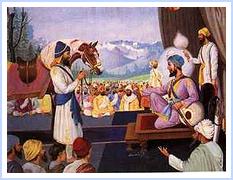 |
One day Baba Gurditta went for a hunting trip. It so happened that one of his Sikhs shot a cow by mistake for a deer. The shepherds came and arrested the offending Sikh. Baba Gurditta went to his assistance and offered to give compensation. The shepherds would have from the Guru's son (Gurditta) nothing less than the restoration of the cow to life. If he restored the cow to life, the Guru would be angry as he was before in the case of Baba Atal and if he refused to satisfy the shepherds, they would detain his Sikh as a hostage. He was at last persuaded to reanimate the cow. When it was reported to the Guru, he remarked,"It is not pleasing to me that any one should set himself up as God's equal, and restore life to the dead. Everybody will be bringing the dead to my door, and whom shall I select for reanimation?" Baba Gurditta replied," Mayest thou live for ever! I depart." He went to Budhan Shah's shrine, drove his cane into the ground, lay down, and left for his heavenly abode at the early age of twenty four in 1638.
After this the Guru sent for Baba Gurditta's eldest son, Dhir Mal, from Kartarpur, and also for the Adi Granth which was in his custody. He intended that the holy volume should be read for the repose of Gurditta's soul, and also that Dhir Mal should be present to receive a turban after his father's death in token of succession to his property and position. Dhir Mal declined the invitation saying,"My father is not in Kiratpur. To whom shall I go? It is through fear of the Guru my father died. I do not desire to die yet. I will myself have the Adi Granth read for my father." Thus he kept holy scripture thinking that whosoever had its custody would be the Guru. Bhai Bidhi Chand had unfinished copy of the Adi Granth which was read at that time. One day the Guru's wife Mata Nanaki asked him,"O my lord, you always show great kindness to Har Rai, who is your grandson, but you never show regard to your own son Tegh Bahadur. Fulfil my wishes to put him on your throne." The Guru replied," Tegh Bahadur is a Guru of Gurus. There is none who can endure the unendurable so well as he. He has obtained divine knowledge and renounced worldly love. If you have patience, the Guruship shall revert to him."
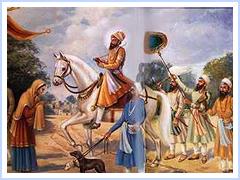 |
 |
A day was appointed for a great assemblage. When all were present, Guru Har Gobind rose, took Har Rai by the hand and seated him on the throne of Guru Nanak. Bhai Bhana, son of Bhai Buddha, affixed thetilak to Har Rai's forehead and decorated him with a necklace of flowers. The Guru putting five paise and a coco-nut in front of him, bowed before him declaring him the Guru, and addressed the Sikhs,"In Har Rai now recognize me. The spiritual power of Guru Nanak hath entered him." Upon this the Sikhs shouted congratulations and minstrels began to sing. After this Guru Har Gobind left this world in March, 1644 at Kiratpur.
When the last rites were completed, Mata Nanaki and her son Tegh Bahadur set out, according to the Guru's order, for Bakala, where they both lived until Tegh Bahadur obtained the Guruship.